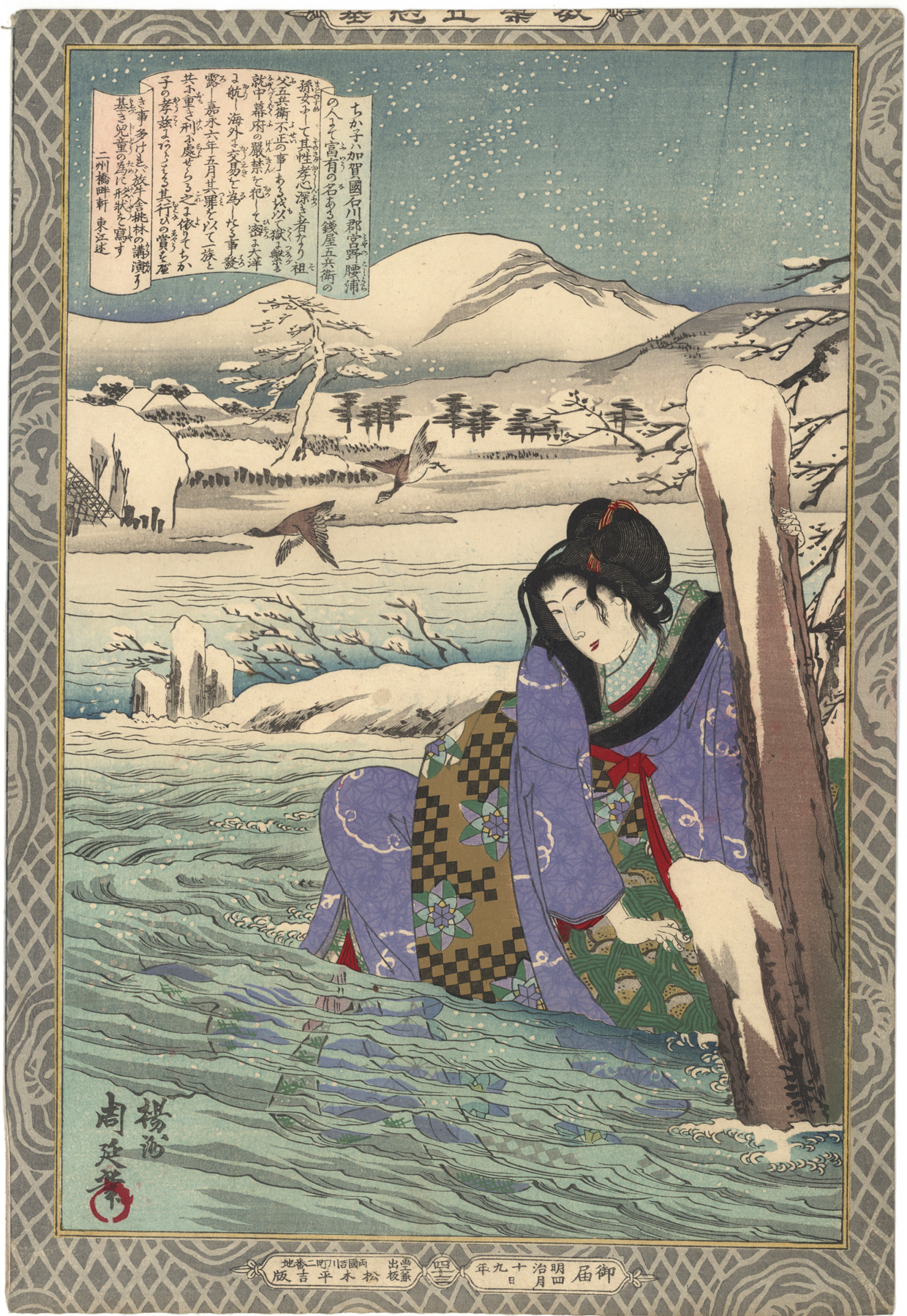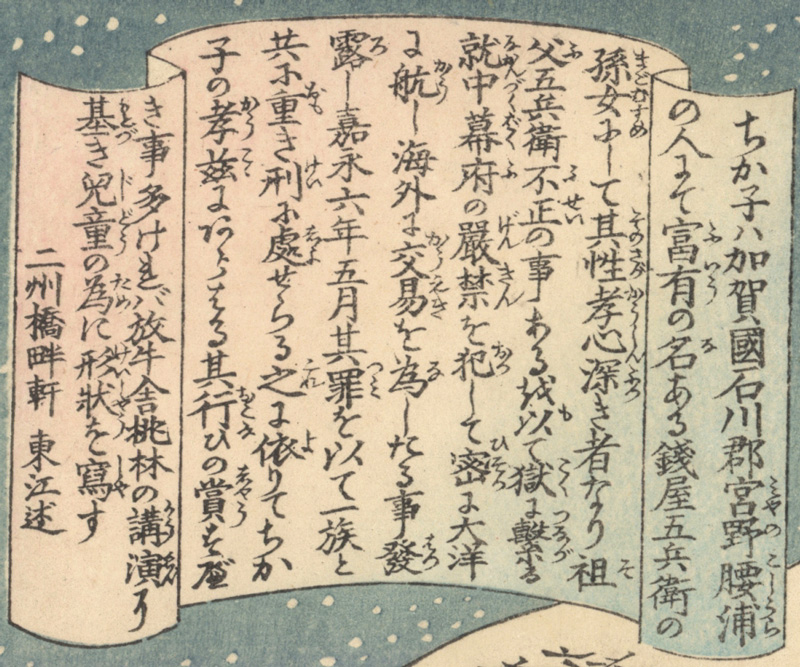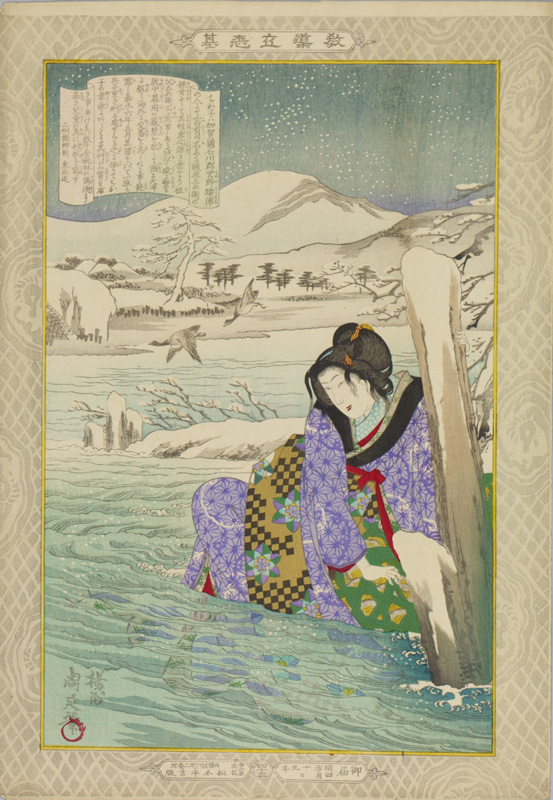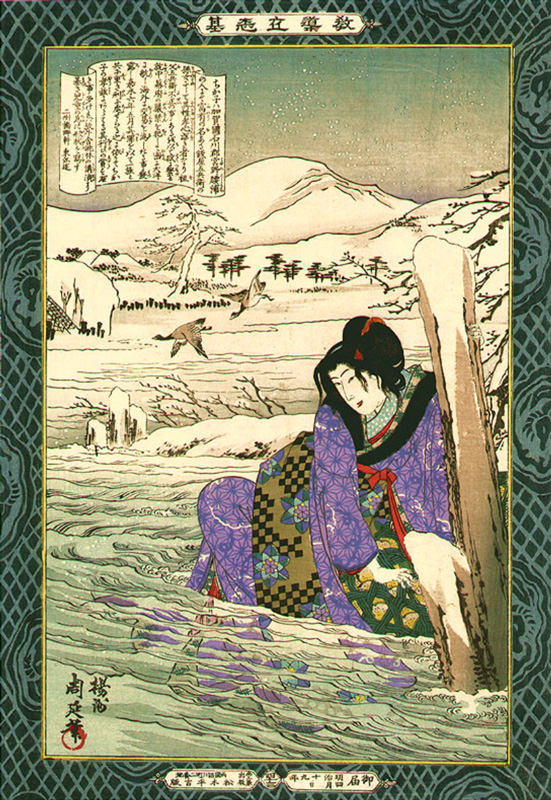About This Print
Print number 43 (四十三)1 in the series Instructive Models of Lofty Ambition picturing Chikako, the daughter of the once wealthy, later disgraced, businessman Zeniya Gohei, just before she commits suicide by jumping into the Asano River.This print is one of two created by Chikanobu for the series, although his name is not listed among the artists appearing on the Table of Contents sheet. [See IHL Cat. 1071.)
1 Numbers were used a bit haphazardly on the prints, with many prints bearing no numbers and some prints displaying numbers on some impressions and not on others. In addition, the same prints can be found bearing different numbers. When print numbers are shown on the print they sometimes do not agree with the placement of their title in the Table of Contents, as is the case with twelve prints, and some print titles that are listed in the Table of Contents do not show a print number on the print, as is the case with seven prints.
The Story of the Chikako
Source: Yoshitoshi's One Hundred Aspects fo the Moon by John Stevenson, #10"This story is taken from actual events which were fairly recent history for Yoshitoshi. Chikako was the daughter of Zeniya Gohei (1798-1855), a ship builder and entrepreneur in northern Japan. During a famine, Gohei became something of a hero when he used his many ships to transport rice to needy areas. At the same time he became very rich. He then proposed to fill in a lake and turn it into rice fields, and borrowed a huge amount of money for the project. The local fishermen violently opposed the scheme, the money ran out, and Zeniya was thrown into jail.
Chikako prayed for her father's release. To demonstrate her sincerity she committed suicide one snowy night by jumping into the Asano river. Her sacrifice was in vain - Zeniya died in prison, and his son was beheaded."
and more detail:
"An ambitious and wealthymerchant, Zeniya Gohei (1798-1855), began in 1851 to fill in Kahoku Lake forthe development of rice paddies. The following year, many dead fish appeared bythe construction site, followed by reports of local residents who had diedafter eating the fish. The issue became a flashpoint, as aggrieved fishermen,envious rival merchants, and general local hysteria prompted the arrest ofGohei and sixty-six others involved in the project. In a futile gesture offilial piety, Gohei's daughter Chikako is said to have drowned herself in thefreezing Asano River. It came to naught, however: her father would succumb to'urinary blockage' and die incarcerated; her siblings were beheaded; and herfamily was stripped of all its wealth."
Detail of Scroll
About The Series "Kyōdō risshi no motoi"
Notes:1. This series is variously translated as "Instructive Models of Lofty Ambition," "Foundations of Learning and Achievement," "Foundation of Instruction and Perseverance," "Self-Made Men Worthy of Emulation," "Paragons of Instruction and Success," "Moral of Success," "Examples of Self-Made Leaders," and "Instruction in the Fundamentals of Success." The title in Japanese is sometimes seen as "Kyōdō risshiki or "Kyōdō risshi no moto," in addition to the most commonly seen transliteration of "Kyōdō risshi no motoi".
2. For a complete listing of all the prints in the series and additional information please see the article on this site titled Instructive Models of Lofty Ambition.
This series ran between October 1885 and November 1890 and featured a long list of heroes and heroines, from antiquity to contemporary times, who were regarded as standards of moral leadership and self-realization.
Source: Kiyochika Artist of Meiji Japan, Henry D. Smith II, Santa Barbara Museum of Art, 1988, p. 74-75; original research and as footnoted.
This series of 58 prints,1 plus a table of contents sheet (目録), were originally published between October 1885 and November 1890 by the Tokyo publisher Matsuki Heikichi 松木平吉.2 The table of contents sheet issued by the publisher states that "fifty prints make up the complete set (五十番揃)". Three prints not in the initial release were added over the five year publication period, as were five redesigns of original prints, eventually increasing the total print count to 58. The seven artists contributing prints were Kobayashi Kiyochika (1847-1915) [20 prints], Mizuno Toshikata (1866-1908) [16 prints], Inoue Tankei (Yasuji) (1864-1889) [13 prints], Taiso (Tsukioka) Yoshitoshi (1839-1892) [5 prints], Yōshū Chikanobu (1838-1912) [2 prints], Toyohara Kunichika (1835–1900) [1 print], and Hachisuka (Utagawa) Kuniaki II (1835-1888) [1 print]. All the artists, with the exception of Yōshū Chikanobu, are listed in the top scroll of the table of contents sheet. Various colors (including blue, blue/green, and tan/brown) were used for the decorative border, and in 1902 the series was re-issued by Matsuki without borders.
This series of 58 prints,1 plus a table of contents sheet (目録), were originally published between October 1885 and November 1890 by the Tokyo publisher Matsuki Heikichi 松木平吉.2 The table of contents sheet issued by the publisher states that "fifty prints make up the complete set (五十番揃)". Three prints not in the initial release were added over the five year publication period, as were five redesigns of original prints, eventually increasing the total print count to 58. The seven artists contributing prints were Kobayashi Kiyochika (1847-1915) [20 prints], Mizuno Toshikata (1866-1908) [16 prints], Inoue Tankei (Yasuji) (1864-1889) [13 prints], Taiso (Tsukioka) Yoshitoshi (1839-1892) [5 prints], Yōshū Chikanobu (1838-1912) [2 prints], Toyohara Kunichika (1835–1900) [1 print], and Hachisuka (Utagawa) Kuniaki II (1835-1888) [1 print]. All the artists, with the exception of Yōshū Chikanobu, are listed in the top scroll of the table of contents sheet. Various colors (including blue, blue/green, and tan/brown) were used for the decorative border, and in 1902 the series was re-issued by Matsuki without borders.
Brief texts contained within a scroll-like cartouche appearing on each print provide historical details. The scroll composer's name is given at the end of the scroll text. The “lofty ambition” of the title is a Confucian concept, originally from Mencius, meaning “righteous determination that would inspire others.” The market for the series probably included former samurai, ambitious youth, and conservative intellectuals.
"[W]hen it was completed in 1890 the publisher was singled out for special recognition by the government for having sponsored such noble subject matter."3
1 The Tokyo Metropolitan Library online collection shows 50 prints and a Table of Contents sheet. The Table of Contents lists the titles of 50 prints. Smith in Kiyochika Artist of Meiji Japan identified 52 prints. I have identified 58 prints from this series including five prints (Ikina, Michizane Sugiwara, Kesa Gozen, Soga Brothers and Hokiichi Hanawa) that were re-designed and re-printed, likely due to damaged or lost blocks.
2 Robert Schaap notes in Appendix II, p. 166 of Yoshitoshi, Masterpieces from the Ed Freis Collection, Chris Uhlenbeck and Amy Reigle Newland, Hotei Publishing, 2011 that the series originally appeared as newspaper supplements.
3 The World of the Meiji Print: Impressions of a New Civilization, Julia Meech-Pekarik, Weatherhill, 1986, p. 122.
Print Details
| IHL Catalog | #2212 |
| Title or Description | Chikako ちか子 |
| Series | “Instructive Models of Lofty Ambition” (Kyōdō risshiki 教導立志基) [note: series is variously translated as "Instructive Models of Lofty Ambition," "Foundations of Learning and Achievement," "Foundation of Instruction and Perseverance," "Self-Made Men Worthy of Emulation," "Paragons of Instruction and Success," "Moral of Success," "Examples of Self-Made Leaders," and "Instruction in the Fundamentals of Success."] |
| Artist | Yōshū Chikanobu (1838-1912) |
| Signature |
 |
| Seal | Toshidama (as shown above) |
| Publication Date | April 13, 1886 明治十九年四月十三日 |
| Publisher | Matsuki Heikichi (松木平吉) proprietor of Daikokuya Heikichi [Marks: seal not shown; pub. ref. 029] click on image to enlarge (from right to left) publishing and printing date: 御届 明治十九年四月十三日 [notification delivered, Meiji 19 4th month 13th day] assigned number within series: 四十三 [43] publisher information: 画工並 出版 両国吉川町二番地 松木平吉 版 [artist and publisher Ryōgoku Yoshikawachō 2-banchi Matsuki Heikichi han] |
| Impression | excellent |
| Colors | excellent |
| Condition | fair - trimmed to image with partial trimming of series title at top of print; album backing |
| Genre | ukiyo-e; rishki-e; kyōiku nishiki-e |
| Miscellaneous | |
| Format | vertical oban |
| H x W Paper | 13 11/16 x 9 1/4 in. (34.8 x 23.5 cm) |
| H x W Image | 12 5/8 x 8 3/16 in. (32.1 x 20.8 cm) area inside brocade border |
| Literature | |
| Collections This Print | Ritsumeikan University Art Research Center AcNo. Z0173-376; Waseda University Theatre Museum 011-0038 |
11/19/2019 created





